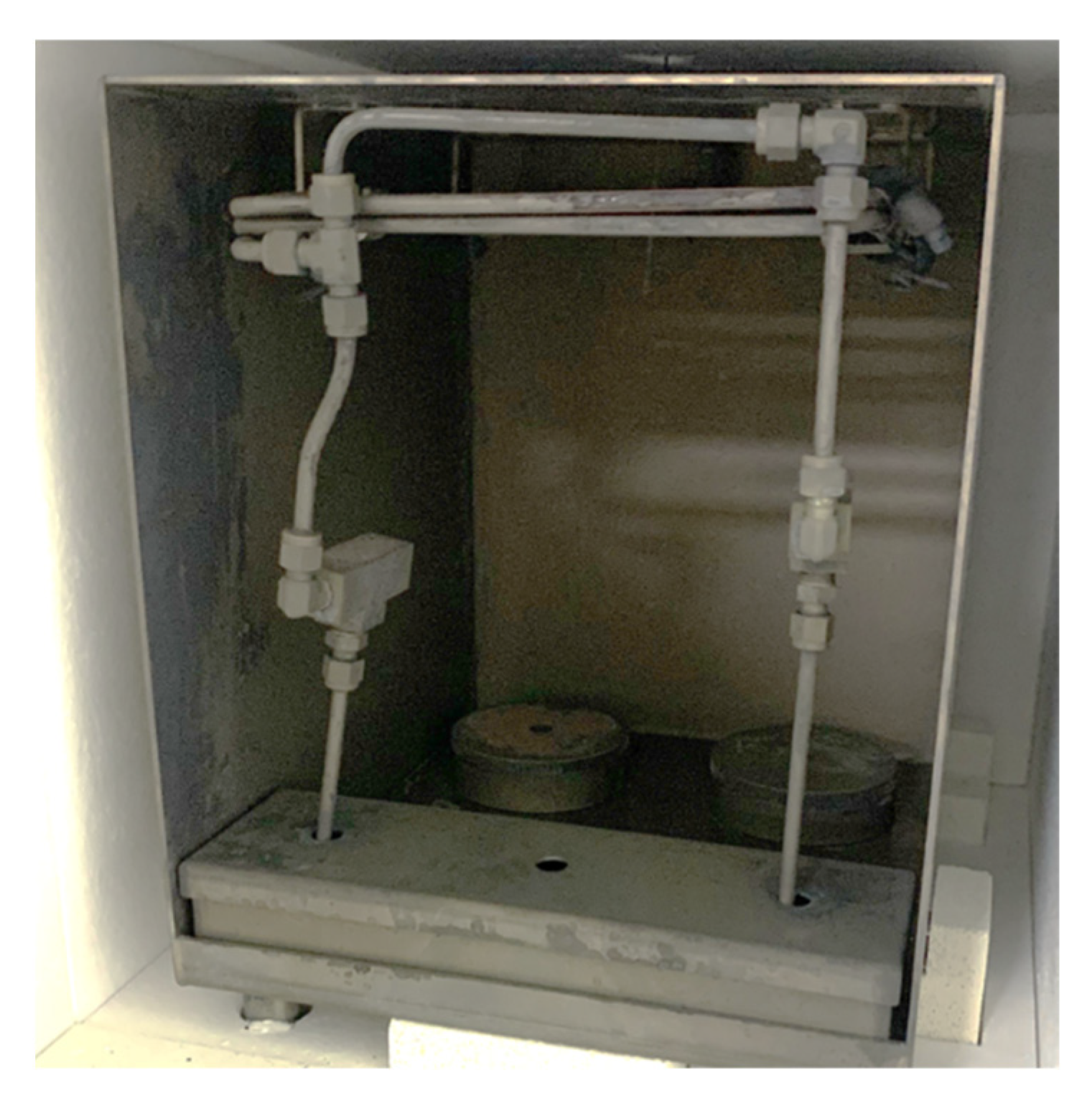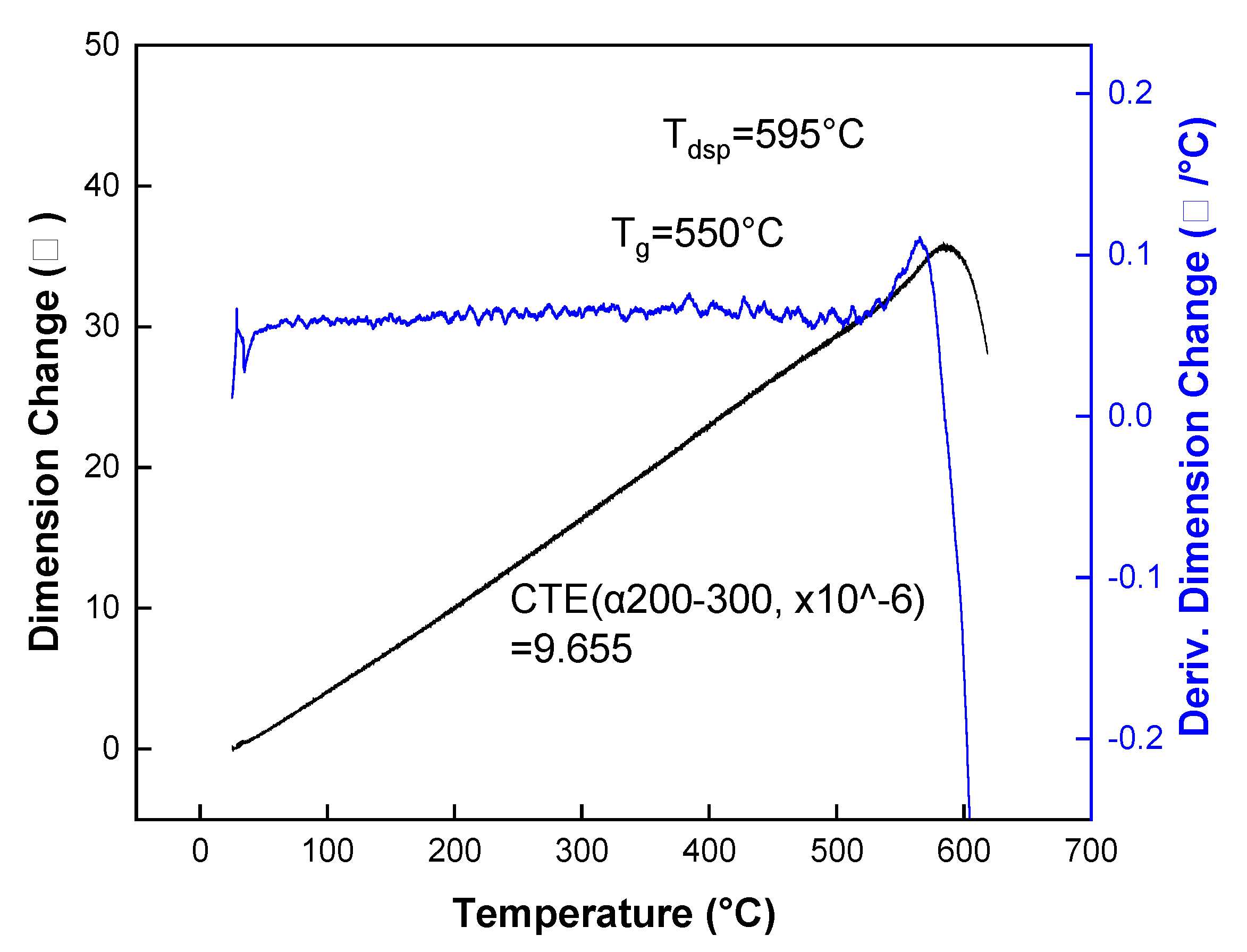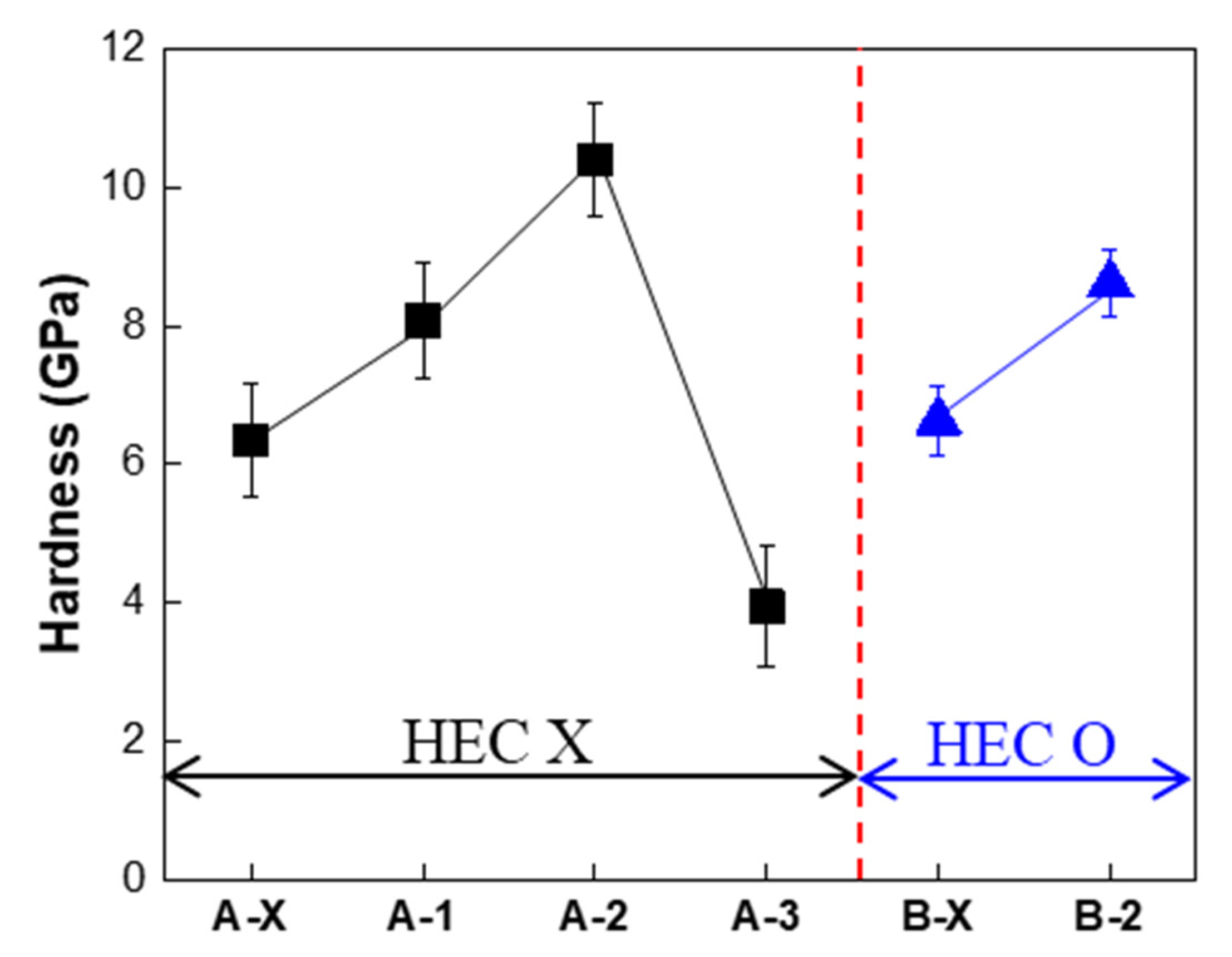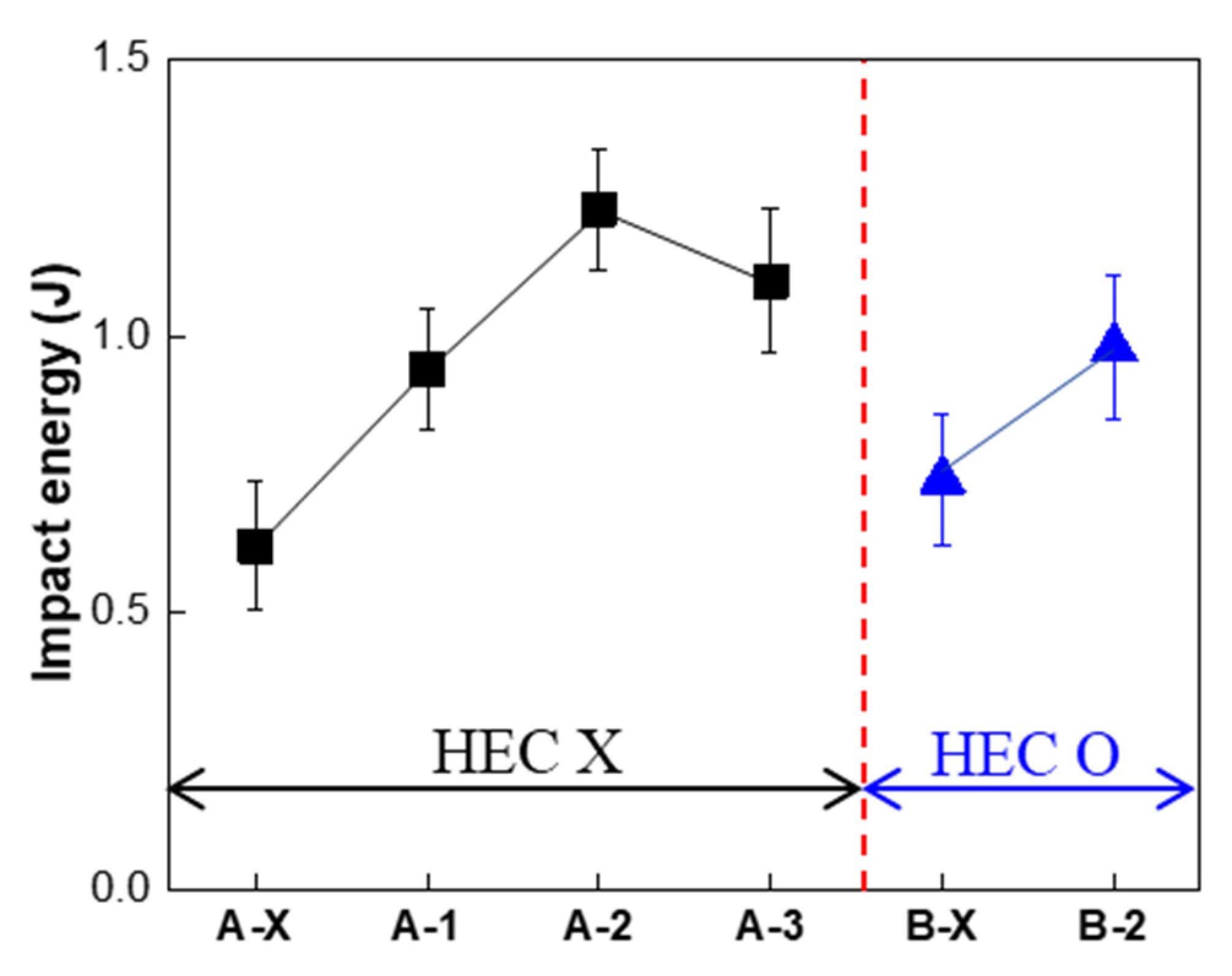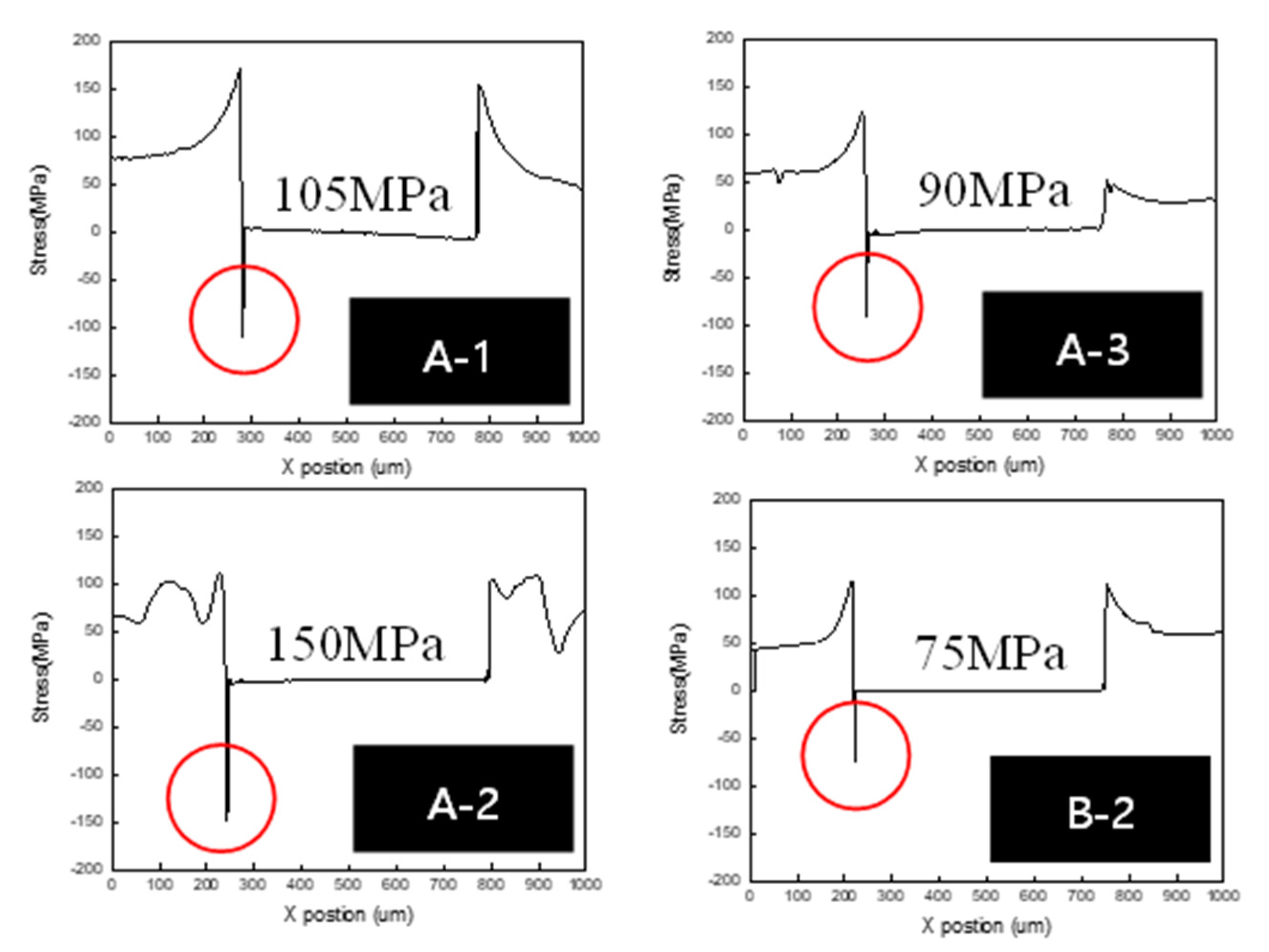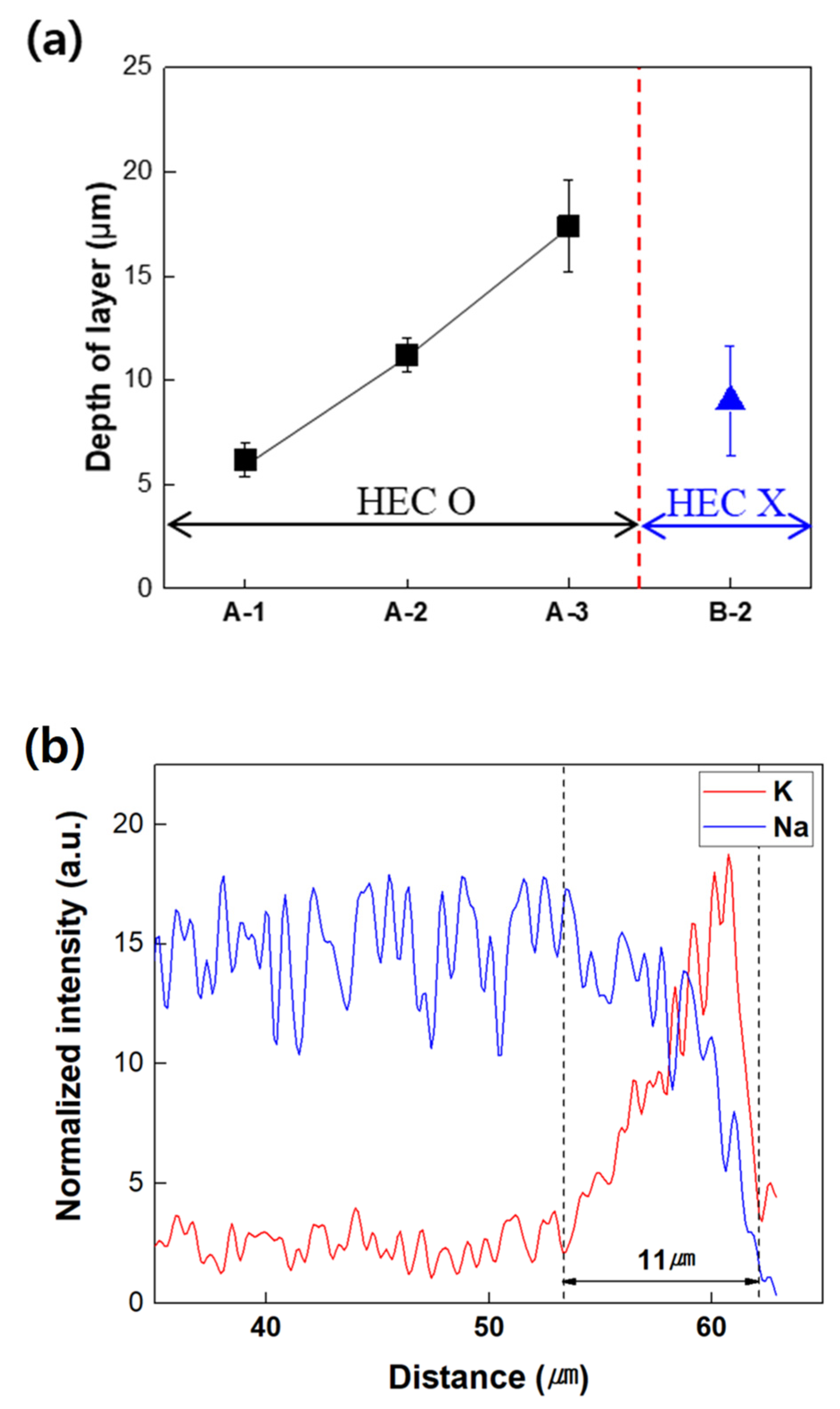1. Introduction
The use of microplastics is a concern worldwide because of their adverse effects on water and aquatic ecosystems and their harmful effects on humans. Various studies have attempted to address this problem. Among these, studies using glass bottles as an alternative to plastic containers are gaining popularity.
For glass to become an eco-friendly alternative container, it must be lightweight and highly durable, which are advantages of plastics. However, glass bottles are relatively heavy and brittle. Many glass bottle companies have attempted to reduce the weight of bottles by thinning the bottles to make them lighter [
1,
2]. However, because glass weight reduction has a trade-off relationship with strength, it is necessary to increase its strength.
Hot-end coating (HEC) increases scratch resistance by coating SnO
2 or TiO
2 on the surface and cold-end coating (CEC) improves the lubricity of bottles by spraying polyethylene on them. Both HEC and CEC have been applied to improve the strength of glass bottles. However, an additional surface strengthening treatment is required to reduce the weight of the glass bottle [
3,
4,
5].
Surface strengthening includes both thermal and chemical strengthening. Thermal strengthening is used for float glass. Some domestic companies apply it to glass containers. Thermal strengthening caused consumer distrust due to problems such as self-destruction. [
6].
Conversely, chemical strengthening is applied using heat treatment by dipping glass into a KNO
3 molten salt [
7,
8,
9,
10,
11,
12,
13,
14]. However, this method is difficult to apply in glass bottle factories which use continuous production processes.
Recently, continuous chemical-strengthening technology has been developed involving spraying chemical strengthening salts onto glass [
15,
16]. Compared to dipping, the spray method is more suitable for continuous coating, but involves relatively less salt. Therefore, the amount of K ion substitution required to achieve chemical strengthening is expected to decrease. However, few studies have investigated the reinforcing effect when the spray method is applied in glass bottle factories.
This study sought to elucidate the chemical-strengthening effect of applying the spray-coating method to the surface of a lightweight glass bottle by inducing compressive stress. The feasibility of achieving chemical strengthening by applying the spray-coating method in a continuous production process was also investigated by evaluation of the presence or absence of HEC in glass bottles, changes observed in physical properties according to the strengthening temperature, and by statistical analysis.
2. Materials and Methods
Figure 1 shows a chemical-strengthening furnace that can perform spray coating. A molten salt container was connected to the sprayer. The spray nozzle is an instrument in which molten salt rises from the molten salt container to the nozzle and is sprayed via the Venturi effect. The glass bottle could be rotated so that the salt could be applied to all sides of the bottle when spraying the molten salt. Therefore, using the chemical-strengthening furnace, the type of molten salt, injection pressure, time, vial rotation speed, and the tempering temperature and time could be controlled. The rotation speed of the glass bottle, the injection pressure, and the injection time were 250 RPM, 3 bar, and 20 s, respectively. The molten salt for strengthening was fixed with KNO
3 (99%, DaeJung, Korea).
The heat-treatment temperature was set to T
g − 50, T
g, and T
g + 50. The heat-treatment holding time was fixed at 1 h in accordance with the annealing time applied in the factory. A total of 20 glass samples were used to evaluate strengthening. In addition, treatment was applied in both the presence and absence of HEC treatment of the glass bottle. HEC-untreated glass bottles were denoted as A and HEC-treated glass bottles as B. A detailed description of the chemically strengthened glass bottles is provided in
Table 1;
Figure 2 shows a thermal expansion graph.
The glass bottles supplied by Company K had a common soda-lime glass composition. The composition and thermal properties of the glass are listed in
Table 2. T
g, T
dsp, and the coefficient of thermal expansion were measured using a thermos mechanical analyzer (Q400, TA Instruments, New Castle, DE, USA).
The Weibull distribution can be used to estimate important life characteristics of a product, such as its reliability or probability of failure and the mean life. After measuring the impact strength, the reliability of the glass bottles, with and without strengthening and HEC treatment, was evaluated using Weibull analysis. Minitab Statistical Software version 2016 was used for the analysis.
3. Results and Discussion
A study was conducted based on the following questions regarding the changes in mechanical properties when glass bottles were chemically strengthened by spraying: (1) Does strengthening occur even if there are insufficient chemical strengthening salts and reinforcement time? (2) If strengthening occurs, what is the required temperature within a limited time period? (3) Does HEC affect the reinforcement? (4) Does chemical strengthening improve reliability? Chemical strengthening was achieved despite the lack of chemical strengthening salt amount and time.Both the hardness and impact strength improved.
Figure 3 and
Figure 4 show the changes in hardness and impact strength values observed according to the chemical-strengthening temperature. Both A-series without HEC treatment and B-series with treatment showed maximum hardness and impact strength when heat treated at Tg. The A-series samples chemically strengthened at a high temperature of Tg + 50 decreased both hardness and impact strength.
Chemical strengthening of soda-lime glass treated at 100 °C lower than the T
g has been reported [
17]. However, in this study, the strengthening time was short, and the quantity of KNO
3 salt was considered insufficient. Hence, heat treatment up to a relatively high temperature T
g was necessary to achieve chemical strengthening of the glass bottle. Therefore, the chemical strengthening potential of the spray method and the temperature required were confirmed. The chemical strengthening occurring following spraying at a temperature higher than T
g can be interpreted as a stress relaxation phenomenon resulting from viscous flow [
18].
For the hardness and impact strength evaluation without HEC treatment, the two-sample t-test p-values obtained were 0.022 and 0.011, respectively (smaller than 0.05). This indicated statistically greater hardness and impact strength values than those obtained with HEC treatment. The improvement in the mechanical properties with HEC treatment (B), which was observed to be smaller than that occurring without HEC treatment (A), can be attributed to hindering of the surface K and Na substitution reaction by HEC.
The relationship between the mechanical properties was determined by analyzing the degree of strengthening.
Figure 5 shows the compressive stress values observed according to the strengthening temperature applied. As for the hardness and impact strength values, the compressive stress increased until the HEC bottle was heat-treated up to T
g. It then decreased when strengthened at T
g + 50. In the samples subjected to HEC treatment (B-2), the compressive stress showed a stress value 50% that of A-2 samples at an equal strengthening temperature.
Figure 6a shows the depth of the reinforced layer (DOL) as a function of the tempering temperature. DOL increased up to Tg + 50. In the HEC-treated samples (B-series), there was no statistically significant difference in the average depth of chemical strengthening compared to the A-2 samples tempered at the same Tg temperature, but the relative variance was large. It is thought to mean that the HEC coating was not uniform for each glass sample.
Figure 7 shows a Weibull graph of the impact strength according to the heat treatment conditions.
Table 3 lists the Weibull modulus (shape parameter). The bottles with HEC treatment (B) had higher Weibull coefficient values than those without HEC treatment (A). All the bottles without HEC treatment (A-series), except those strengthened at T
g − 50, had a lower Weibull modulus than those without heat treatment. However, in those with HEC treatment (B-series), the Weibull modulus increased after strengthening.
The Weibull modulus is the slope of the Weibull distribution graph, which indicates the reliability [
19,
20,
21]. Regardless of whether chemical strengthening or HEC was applied, the Weibull coefficients all exceeded one. The failure rate increased according to the amount of impact. Those exceeding 3.5 had an approximately normal probability distribution. This implies that gradual failure occurs in response to changes in the impact strength.
The A-2 and B-2 samples were subject to different HEC treatments. The A-2 samples had higher average strength, but the Weibull modulus value was small. This means that A-2 showed greater strength, but that the bottle breakage probability distribution was relatively wide. From a long-term perspective, the application of both HEC and chemical strengthening at the same time is recommended as a more effective method for strengthening glass containers.
4. Conclusions
In this study, the effects of heat treatment temperature and HEC treatment on the mechanical properties of glass were investigated by chemically strengthening glass bottles with spray coating.
When a spray-coating method with less K substitution for diffusion was used compared to a dipping method, the glass hardness and impact strength were improved by up to 163% and 198%, respectively, even if the samples were strengthened over a short period. The mechanical properties of the glass were improved by chemical strengthening irrespective of HEC coating. The effect of chemical strengthening was relatively large in the absence of HEC. However, the Weibull modulus was higher in the distribution of impact strength for glass bottles to which HEC was applied. Therefore, it is necessary to apply both HEC and chemical strengthening to create a lightweight glass bottle with excellent mechanical properties and high reliability.
The results of this study suggest that spray-based chemical strengthening can be used in conventional manufacturing processes. This means that strength enhancement in lightweight bottles can be achieved through chemical strengthening without adversely affecting continuous glass bottle production. However, it is also necessary to consider how to ensure that the surfaces of all containers are chemically and uniformly hardened. Since there are also returnable bottles, we plan to review whether chemical reinforcement exerts its effect even when reused.
Author Contributions
Conceptualization, methodology, formal analysis and writing—original draft, K.W.M. and H.-J.K.; data curation, Y.J. and Y.M.B.; review and editing, W.B.I. and J.H.C.; project administration and funding acquisition, H.-J.K. All authors have read and agreed to the published version of the manuscript.
Funding
This study was supported by the Ministry of Trade, Industry, and Energy (Korea) [20010268]. [Project Name: Development of super-lightweight high-strength glass manufacturing technology to reduce microplasticity].
Data Availability Statement
Not applicable.
Conflicts of Interest
The authors declare no conflict of interest.
References
- Sarwar, M.; Armitage, A.W. Tooling Requirements for Glass Container Production for the Narrow Neck Press and Blow Process. J. Mater. Process. Technol. 2003, 139, 160–163. [Google Scholar] [CrossRef]
- Jaime, S.B.M.; Ortiz, S.A.; Dantas, T.B.; Damasceno, C.F. A Comparison of the Performance of Lightweight Glass Containers Manufactured by the P&B and B&B Processes. Packag. Technol. Sci. 2002, 15, 225–230. [Google Scholar] [CrossRef]
- Jackson, J.D.J.; Rand, B.; Rawson, H. Metallurgical and protective coatings glass surface coatings resistant to mechanical damage. Thin Solid Film. 1981, 77, 5–12. [Google Scholar] [CrossRef]
- Southwick, R.D.; Wasylyk, J.S.; Smay, G.L.; Kepple, J.B.; Smith, E.C.; Augustsson, B.O. The metallurgical and protective coatings 41 the mechanical properties of films for the protection of glass surfaces. Thin Solid Film. 1981, 77, 41–50. [Google Scholar] [CrossRef]
- Jackson, N.; Ford, J. Metallurgical and protective coatings 23 experience in the control and evaluation of coatings on glass containers. Thin Solid Film. 1981, 77, 23–40. [Google Scholar] [CrossRef]
- Li, F. Investigation on Self-Explosion of Glass Bottles. Glass Enamel-China 1999, 27, 28–31. [Google Scholar]
- Wondraczek, L.; Mauro, J.C.; Eckert, J.; Kühn, U.; Horbach, J.; Deubener, J.; Rouxel, T. Towards Ultrastrong Glasses. Adv. Mater. 2011, 23, 4578–4586. [Google Scholar] [CrossRef]
- Käfer, D.; He, M.; Li, J.; Pambianchi, M.S.; Feng, J.; Mauro, J.C.; Bao, Z. Ultra-Smooth and Ultra-Strong Ion-Exchanged Glass as Substrates for Organic Electronics. Adv. Funct. Mater. 2013, 23, 3233–3238. [Google Scholar] [CrossRef]
- Mauro, J.C.; Tandia, A.; Vargheese, K.D.; Mauro, Y.Z.; Smedskjaer, M.M. Accelerating the Design of Functional Glasses through Modeling. Chem. Mater. 2016, 28, 4267–4277. [Google Scholar] [CrossRef]
- Talimian, A.; Sglavo, V.M. Ion-Exchange Strengthening of Borosilicate Glass: Influence of Salt Impurities and Treatment Temperature. J. Non-Cryst. Solids 2017, 456, 12–21. [Google Scholar] [CrossRef]
- Nordberg, M.E.; Mochel, E.; Garfinkel, H.M.; Olcott, J.S. Strengthening by Ion Exchange. J. Am. Ceram. Soc. 1964, 47, 215–219. [Google Scholar] [CrossRef]
- Fu, A.I.; Mauro, J.C. Mutual Diffusivity, Network Dilation, and Salt Bath Poisoning Effects in Ion-Exchanged Glass. J. Non-Cryst. Solids 2013, 363, 199–204. [Google Scholar] [CrossRef]
- Varshneya, A.K. Chemical Strengthening of Glass: Lessons Learned and Yet To Be Learned. Int. J. Appl. Glass Sci. 2010, 1, 131–142. [Google Scholar] [CrossRef]
- Kistler, S.S. Stresses in Glass Produced by Nonuniform Exchange of Monovalent Ions. J. Am. Ceram. Soc. 1962, 45, 59–68. [Google Scholar] [CrossRef]
- Kim, S.W.; Im, H.T.; Lee, J.E.; Kim, H.S.; Kim, J.H.; Hwang, J. Physical Properties of Chemically Strengthened Thin Glass Prepared by the Spray Method Using an Original KNO3–Al2O3 Slurry. Mater. Chem. Phys. 2021, 259, 123942. [Google Scholar] [CrossRef]
- Lee, J.E.; Im, H.T.; Kim, H.S.; Kim, S.W.; Kim, J.H.; Ryu, B.K.; Hwang, J. Effect of α-Al2O3particle Size in a Slurry on the Physical Properties of Chemically Strengthened Thin Glass Prepared by the Spray Method. ACS Omega 2020, 5, 26667–26672. [Google Scholar] [CrossRef]
- Jiang, L.; Guo, X.; Li, X.; Li, L.; Zhang, G.; Yan, Y. Different K + -Na + Inter-Diffusion Kinetics between the Air Side and Tin Side of an Ion-Exchanged Float Aluminosilicate Glass. Appl. Surf. Sci. 2013, 265, 889–894. [Google Scholar] [CrossRef]
- Shen, J.; Green, D.J. Prediction of Stress Profiles in Ion Exchanged Glasses. J. Non-Cryst. Solids 2004, 344, 79–87. [Google Scholar] [CrossRef]
- Wang, M.; Jiang, L.; Li, X.; Liu, J.; Li, J.; Yan, Y. Structure and Mechanical Response of Chemically Strengthened Aluminosilicate Glass under Different Post-Annealing Conditions. J. Non-Cryst. Solids 2021, 554, 120620. [Google Scholar] [CrossRef]
- Han, Z.; Tang, L.C.; Xu, J.; Li, Y. A Three-Parameter Weibull Statistical Analysis of the Strength Variation of Bulk Metallic Glasses. Scr. Mater. 2009, 61, 923–926. [Google Scholar] [CrossRef]
- Nouri, A.S.; Gu, X.J.; Poon, S.J.; Shiflet, G.J.; Lewandowski, J.J. Chemistry (Intrinsic) and Inclusion (Extrinsic) Effects on the Toughness and Weibull Modulus of Fe-Based Bulk Metallic Glasses. Philos. Mag. Lett. 2008, 88, 853–861. [Google Scholar] [CrossRef]
| Disclaimer/Publisher’s Note: The statements, opinions and data contained in all publications are solely those of the individual author(s) and contributor(s) and not of MDPI and/or the editor(s). MDPI and/or the editor(s) disclaim responsibility for any injury to people or property resulting from any ideas, methods, instructions or products referred to in the content. |
© 2022 by the authors. Licensee MDPI, Basel, Switzerland. This article is an open access article distributed under the terms and conditions of the Creative Commons Attribution (CC BY) license (https://creativecommons.org/licenses/by/4.0/).
